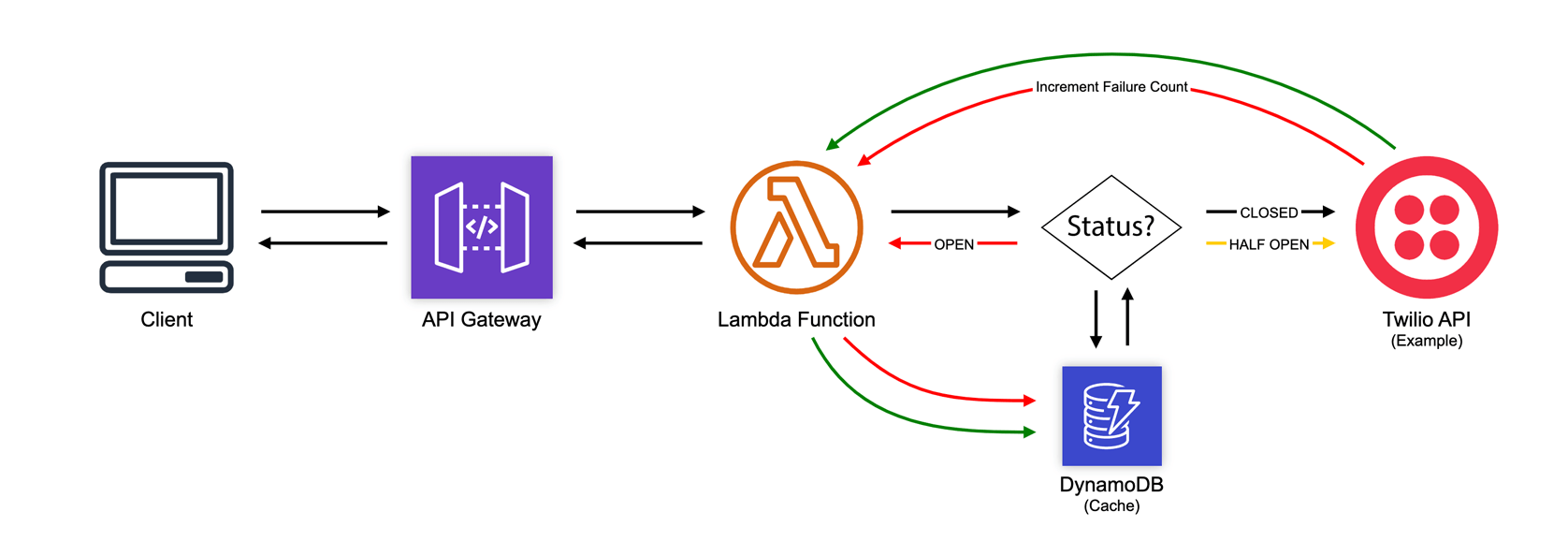The Circuit Breaker

Interactive Reference Architecture
Click on the components or numbered steps below to explore how this architecture works.
The Circuit Breaker pattern keeps track of the number of failed (or slow) API calls by using a cache to share the status across multiple Lambda functions. In this example, we're using a DynamoDB table so that we can avoid using a VPC. If you were in a VPC already, ElastiCache would be a good alternative.
Here's how it works. When the number of failures reaches a certain threshold, we "open" the circuit and send errors back to the calling client immediately without even trying to call the API. After a short period of time, we "half open" the circuit, sending just a few requests through to see if the API is finally responding correctly. All other requests receive an error. If the sample requests are successful, we "close" the circuit and start letting all traffic through. However, if some or all of those requests fail, the circuit stays "open", and the process repeats with some algorithm for increasing the timeout between "half open" retry attempts.
This is an incredibly powerful (and cost saving) pattern for any type of synchronous request to an API or downstream system. You are accumulating charges whenever a Lambda function is running and waiting for another task to complete. Allowing your systems to self-identify issues like this, provide incremental backoff, and then self-heal when the service comes back online, adds a tremendous amount of resiliency to your applications.
Deploy this Pattern
Below are the basic configurations for deploying this pattern using different frameworks and platforms. Additional configuration for your environment will be necessary. The source files and additional examples are available in the GitHub repo.
-
-
SAM
-
Stackery
-
Serverless Framework
yamlservice: simple-web-service provider: name: aws runtime: nodejs12.x stage: ${opt:stage,'dev'} region: us-east-1 stackName: ${self:service}-${self:provider.stage} stackTags: SERVICE: ${self:service} httpApi: payload: '2.0' cors: true functions: GetUser: handler: index.handler memorySize: 1024 timeout: 6 tracing: Active environment: TABLE_NAME: !Ref Users TABLE_ARN: !GetAtt Users.Arn iamRoleStatementsName: ${self:service}-${self:provider.stage}-getuser-role iamRoleStatements: - Effect: Allow Action: - dynamodb:getItem - dynamodb:putItem - dynamodb:updateItem - dynamodb:deleteItem Resource: - !Join [ '/', [ !GetAtt Users.Arn, '*' ] ] - !GetAtt Users.Arn - Effect: Allow Action: - xray:PutTraceSegments - xray:PutTelemetryRecords Resource: "*" events: - httpApi: path: /user/{id} method: get plugins: - serverless-iam-roles-per-function resources: Resources: Users: Type: AWS::DynamoDB::Table Properties: AttributeDefinitions: - AttributeName: id AttributeType: S BillingMode: PAY_PER_REQUEST KeySchema: - AttributeName: id KeyType: HASH StreamSpecification: StreamViewType: NEW_AND_OLD_IMAGES
-